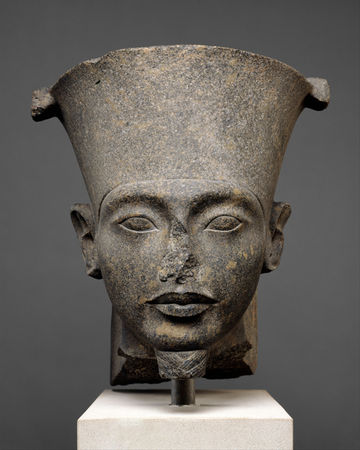"Tutankhamun’s Funeral" @ The Metropolitan Museum of Art
Floral collar. Diam. 47 cm (18 ½ in). The Metropolitan Museum of Art, Gift of Theodore M. Davis, 1909
NEW YORK, NY.- n 1908, while excavating in the Valley of the Kings in Egypt, American archaeologist Theodore Davis discovered about a dozen large storage jars. Their contents included broken pottery, bags of natron (a mixture of sodium carbonate, sodium bicarbonate, sodium sulphate, and sodium chloride that occurs naturally in Egypt), bags of sawdust, floral collars, and pieces of linen with markings from years 6 and 8 during the reign of a then little-known pharaoh named Tutankhamun. The Metropolitan Museum of Art was given six of the vessels and a good part of their contents in 1909.
In time, Herbert Winlock, curator and field director of the Metropolitan's Egyptian excavations and in the 1930s Director of the Museum, came to realize that the natron and linen were the embalming refuse from the mummification of Tutankhamun. He also suggested that the animal bones, pottery, and collars might have come from a funeral meal. Winlock's analysis was an important clue that led to Howard Carter's 1922 discovery of Tutankhamun's tomb some 110 meters away.
Opening March 16 at the Metropolitan Museum, the exhibition Tutankhamun's Funeral will explore the materials and rituals associated with the burial of the pharaoh. The presentation will include some 60 objects, primarily from the Metropolitan's own collection.
The exhibition will feature jars, lids, bowls, floral collars, linen sheets, and bandages that were used at the pharaoh's mummification and the rites associated with his burial. Related objects will also be shown. These include a sculpted head of the youthful Tutankhamun and several facsimile paintings depicting funerary rituals. Archival photographs from the early 20th century by Harry Burton, the Museum's expedition photographer, will provide an evocative background.
Although few facts are known about the brief life of Tutankhamun (reign ca. 1336–1327 B.C.), scholars studying the funerary cache have been able to reconstruct details of his death and burial. For example, botanical analysis of the well-preserved, more than 3,000-year-old floral collars indicates that the plants they contain flower in Egypt between late February and mid–March. Since the complex process of mummification took about 70 days, it is now believed that Tutankhamun probably died in December or January.
Often called the "boy-king," Tutankhamun was about nine years old when he ascended the throne of ancient Egypt; he died approximately nine years later, possibly owing to causes that include disease and a broken bone. His death may have been unexpected, so that his own tomb was still unfinished; the rather small tomb in which he was actually buried had been started for another person, not for a king. Eventually, workmen's huts completely hid the entrance to the tomb, and its location was forgotten. The discovery of the storage vessels and the accurate identification of their contents were instrumental in leading Howard Carter to his great discovery.
Stela of Userhat and his wife Nefertari; Userhat is the only known mortuary priest of Tutankhamun. From Thebes, Limestone h. 42.5 cm (16 ¾ in) Late Dynasty 18, ca. 1327-1295 B.C. The Metropolitan Museum of Art, Gift of the Egypt Exploration Fund, 1905.
Shawabti of Akhenaten, New Kingdom, Amarna Period, H. 11 cm, (4 5/16 in); w. 7.8 cm (3 1/16 in); d. 5.6 cm (2 3/16 in) Dynasty 18. ca. 1353–1336 B.C. The Metropolitan Museum of Art, Purchase, Fletcher Fund and The Guide Foundation Inc. Gift, 1966
Head of Tutankhamun, New Kingdom, Amarna Period, Dynasty 18, ca. 1336–1327 B.C. Limestone (indurated) H. 42.5 cm (16 3/4 in.); d. 23 cm (9 1/16 in) The Metropolitan Museum of Art, Rogers Fund, 1950
Jewelry Elements for a Broad Collar, New Kingdom, Amarna Period, Dynasty 18, ca. 1353–1323 B.C. Faience. The Metropolitan Museum of Art, Gift of Mrs. John Hubbard and Egypt Exploration Society, 1931
Standing figure of Amenhotep III, New Kingdom, Dynasty 18, ca. 1391–1353 B.C. Serpentine. H. 23 cm (9 1/16 in); w. 5.5 cm (2 3/16 in.); d. 10.2 cm (4 in) The Metropolitan Museum of Art, Theodore M. Davis Collection, Bequest of Theodore M. Davis, 1915
Jar from the tomb of Sennedjem. New Kingdom, Ramesside. Dynasty 19, ca. 1279–1213 B.C. Pottery, paint. H. 30.5 cm (12 in); w. 16 cm (6 5/16 in) The Metropolitan Museum of Art, Funds from various donors, 1886
Head of the god Amun, New Kingdom, Post-Amarna Period, Dynasty 18, ca. 1336–1327 B.C. Granodiorite, H. 44 cm (17 5/16 in), w. 38.2 (15 1/16 in); d. 41.5 (16 5/16 in.) The Metropolitan Museum of Art, Rogers Fund, 1907
Water Bottle from Tutankhamun's Embalming Cache, New Kingdom, Dynasty 18, ca. 1336–1327 B.C., Pottery, hematite wsh, burnished, pigment, H. 37 cm (14 9/16 in); diam. 15 cm (5 7/8 in); diam. of mouth 12 cm (4 3/4 in) The Metropolitan Museum of Art, Gift of Theodore M. Davis, 1909

/https%3A%2F%2Fprofilepics.canalblog.com%2Fprofilepics%2F1%2F0%2F100183.jpg)











/http%3A%2F%2Fstorage.canalblog.com%2F81%2F20%2F119589%2F64171515_p.jpg)
/http%3A%2F%2Fstorage.canalblog.com%2F22%2F89%2F119589%2F50343813_p.jpg)
/http%3A%2F%2Fstorage.canalblog.com%2F22%2F30%2F119589%2F48646176_p.jpg)
/http%3A%2F%2Fstorage.canalblog.com%2F60%2F96%2F577050%2F36858834_o.jpg)